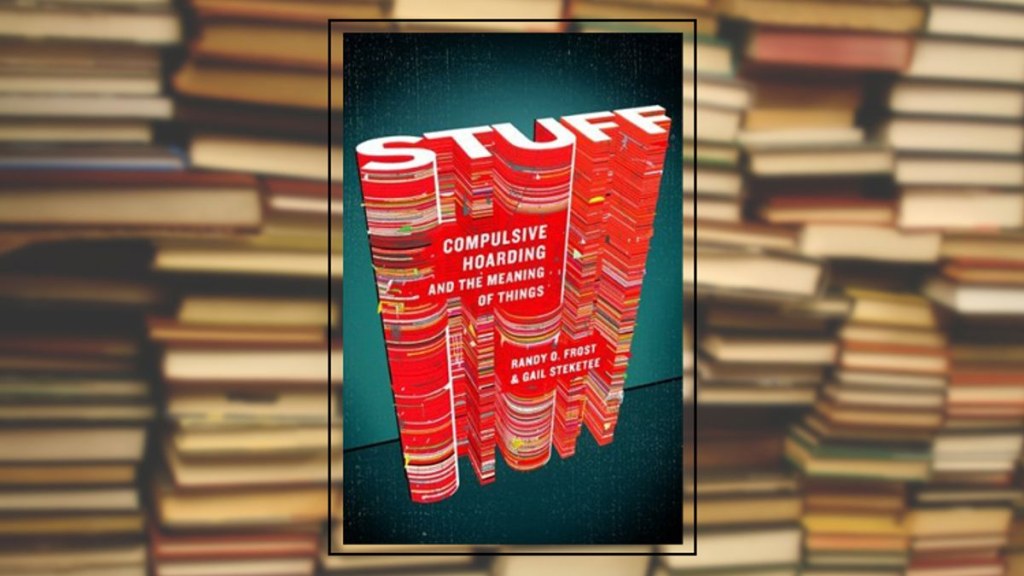The Power Of ‘Stuff’: Unveiling Compulsive Hoarding And Exploring The Meaning Behind Things
Stuff Compulsive Hoarding and the Meaning of Things
Greetings, Smart Peoples! In this article, we will delve into the intriguing world of stuff compulsive hoarding and explore the deep meaning behind our possessions. Hoarding is a complex psychological disorder that affects millions of people worldwide. By understanding the reasons behind this behavior and examining the significance of our belongings, we can gain valuable insights into the human psyche. So, let’s embark on this enlightening journey together.
Introduction
1. Definition of Compulsive Hoarding and Its Prevalence
3 Picture Gallery: The Power Of ‘Stuff’: Unveiling Compulsive Hoarding And Exploring The Meaning Behind Things



Compulsive hoarding, also known as hoarding disorder, is a persistent difficulty discarding or parting with possessions, regardless of their actual value. It is characterized by excessive accumulation of items and an inability to organize or maintain a clutter-free living space. According to the American Psychiatric Association, hoarding affects approximately 2-6% of the population.

Image Source: walmartimages.com
2. Historical Background and Cultural Perspectives
Hoarding is not a new phenomenon and has been observed throughout history. Various cultures have different views on hoarding, ranging from hoarding being seen as a sign of prosperity to it being viewed as a mental illness. Exploring these cultural perspectives can provide a broader understanding of the issue.
3. Psychological Causes and Underlying Factors

Image Source: salon.com
There are several psychological causes and underlying factors that contribute to compulsive hoarding. These include anxiety disorders, perfectionism, trauma, and attachment issues. Understanding these root causes can help in developing effective strategies for treatment and support.
4. Impact on Daily Life and Relationships

Image Source: ebayimg.com
Hoarding can have severe consequences on one’s daily life and relationships. Living in cluttered and unsafe conditions can lead to isolation, health problems, and strained relationships with family and friends. Examining these effects can highlight the urgency of addressing hoarding disorder.
5. The Meaning Behind Possessions
Our possessions often hold deep emotional and psychological significance. They can represent our memories, identity, and sense of security. Exploring the meaning behind our belongings can shed light on why individuals are compelled to hoard and how they find comfort in their possessions.
6. The Role of Therapy and Support in Recovery
Treating compulsive hoarding requires a comprehensive approach that combines therapy, medication, and support from loved ones. Cognitive-behavioral therapy (CBT) and exposure and response prevention (ERP) are commonly used to help individuals overcome hoarding behaviors and develop healthier coping mechanisms.
7. Breaking the Stigma and Raising Awareness
There is still a significant stigma surrounding hoarding, often leading individuals to suffer in silence. By raising awareness and promoting understanding, we can create a more compassionate society that supports those struggling with compulsive hoarding and encourages them to seek help.
What is Stuff Compulsive Hoarding?
Compulsive hoarding is a disorder characterized by the excessive accumulation of possessions and the inability to discard them. People with hoarding disorder often have persistent difficulty parting with items, regardless of their value or usefulness. This behavior eventually leads to cluttered living spaces that become unmanageable and pose safety risks.
Causes:
1. Anxiety and Emotional Attachment
Many individuals with hoarding disorder experience high levels of anxiety when confronted with the idea of getting rid of their possessions. They may develop emotional attachments to objects, believing that they provide comfort or a sense of security.
2. Perfectionism and Fear of Making the Wrong Decision
Perfectionism plays a significant role in hoarding disorder, as individuals fear making the wrong decision about what to keep or discard. This fear often leads to an accumulation of items and an inability to declutter.
3. Trauma and Loss
Hoarding can also be linked to trauma and loss. Some individuals may develop hoarding behaviors as a way to cope with past traumas or to preserve a sense of control over their lives.
4. Genetic and Environmental Factors
Research suggests that genetic and environmental factors may contribute to the development of hoarding disorder. Studies have shown that hoarding tendencies can run in families, indicating a possible genetic component. Additionally, growing up in an environment where hoarding behaviors are present can increase the likelihood of developing the disorder.
5. Brain Abnormalities
Brain imaging studies have revealed that individuals with hoarding disorder may have abnormalities in the areas of the brain responsible for decision-making and emotional regulation. These findings suggest that there may be neurological factors contributing to the disorder.
Who is Affected by Compulsive Hoarding?
Compulsive hoarding can affect people of all ages, genders, and socioeconomic backgrounds. While the disorder can manifest in childhood, it often becomes more severe in adulthood. It is estimated that hoarding affects approximately 2-6% of the population, making it a relatively common mental health issue.
Demographics:
1. Age and Gender
Hoarding behaviors can start as early as adolescence, but the disorder typically becomes more pronounced in adulthood. Studies have shown that hoarding affects both men and women equally, dispelling the notion that it is predominantly a female issue.
2. Socioeconomic Status
Hoarding disorder does not discriminate based on socioeconomic status. It can affect individuals from all income levels, although the severity of the hoarding behaviors may vary. People from disadvantaged backgrounds may face additional challenges in seeking help due to limited resources.
3. Comorbidity with Other Mental Health Conditions
Compulsive hoarding often coexists with other mental health conditions, such as anxiety disorders, depression, obsessive-compulsive disorder (OCD), and attention deficit hyperactivity disorder (ADHD). These comorbidities can complicate the diagnosis and treatment of hoarding disorder.
4. Impact on Family Members
Hoarding disorder not only affects the individuals who hoard but also has a significant impact on their family members. Loved ones may struggle to understand the hoarding behaviors and feel overwhelmed by the clutter and chaos in the living environment.
When Does Compulsive Hoarding Become a Problem?
Compulsive hoarding becomes a problem when it starts to interfere with an individual’s daily life and well-being. The severity of the hoarding behaviors can vary, but common signs that hoarding has become problematic include:
Signs and Indicators:
1. Inability to Discard Items
Individuals with hoarding disorder find it extremely challenging to part with their possessions, even when they are no longer functional or necessary. They may experience intense distress at the thought of getting rid of items.
2. Cluttered Living Spaces
Hoarding leads to the accumulation of excessive items, which eventually results in cluttered living spaces. Rooms become inaccessible, and clutter can block entrances or pose safety hazards, such as fire risks and vermin infestations.
3. Impaired Functioning
Hoarding interferes with an individual’s ability to function in daily life. It may become challenging to perform essential tasks, such as cooking, cleaning, and personal hygiene. Relationships suffer, and isolation often occurs.
4. Emotional Distress
People with hoarding disorder often experience significant emotional distress related to their hoarding behaviors. They may feel overwhelmed, anxious, or ashamed about their living conditions and difficulty controlling their accumulation of possessions.
5. Decline in Quality of Life
Hoarding disorder has a profound negative impact on an individual’s overall quality of life. It can lead to social isolation, deteriorating physical health, strained relationships, financial difficulties, and even homelessness in extreme cases.
Where Does Compulsive Hoarding Occur?
Compulsive hoarding can occur in any living environment, including houses, apartments, and even vehicles. The hoarding behaviors often extend beyond the living spaces and can affect garages, storage units, and other areas intended for storage.
Common Hoarding Areas:
1. Living Spaces
The primary living spaces, such as bedrooms, living rooms, and kitchens, are often the areas most affected by hoarding. These spaces become cluttered and unusable, making it challenging to carry out everyday activities.
2. Storage Areas
Hoarding behaviors frequently extend to storage areas, such as attics, basements, and garages. These spaces become filled with accumulated items, making it challenging to access stored belongings or use these areas for their intended purpose.
3. Personal Vehicles
Some individuals with hoarding disorder may also accumulate possessions in their personal vehicles. This can lead to unsafe driving conditions and an inability to transport passengers or belongings effectively.
4. External Storage Units
In more severe cases of hoarding, individuals may rent external storage units to accommodate their excess possessions. These units can become packed to capacity, resulting in significant financial costs and ongoing hoarding behaviors.
Why Do People Engage in Compulsive Hoarding?
Compulsive hoarding is a complex behavior that is influenced by various factors. Understanding the motivations behind hoarding can provide valuable insights into the disorder and help guide treatment approaches.
Motivations:
1. Emotional Attachment and Sentimental Value
Many people with hoarding disorder develop emotional attachments to their possessions. They believe that these items hold sentimental value and provide a sense of comfort and security.
2. Fear of Losing Important Information
Individuals with hoarding disorder may fear that discarding items will result in losing important information or memories. They feel a compulsive need to hold onto physical objects to preserve the associated knowledge or experiences.
3. Perceived Need for Control
Hoarding behaviors can stem from a perceived need for control. People with hoarding disorder may believe that keeping their possessions gives them a sense of control over their lives, even if it leads to chaos and clutter.
4. Anxiety and Decision-Making Difficulties
Hoarding is often linked to anxiety and decision-making difficulties. The fear of making the wrong decision about what to keep or discard can result in an accumulation of items and an inability to declutter.
5. Avoidance of Negative Emotions
Some individuals engage in hoarding behaviors as a way to avoid negative emotions or memories associated with loss or trauma. The act of acquiring and surrounding themselves with possessions serves as a distraction or coping mechanism.
How Does Compulsive Hoarding Affect Individuals and Their Surroundings?
Compulsive hoarding has wide-ranging effects on individuals, their relationships, and their living environments. These effects can be both positive and negative, highlighting the complexities of the disorder.
Advantages and Disadvantages:
1. Advantages of Hoarding
– Sense of Security: Hoarding can provide individuals with a sense of security and emotional comfort, especially during times of stress or anxiety.
– Preservation of Memories: Hoarding allows individuals to preserve memories by surrounding themselves with physical reminders of important events or people.
– Creativity and Inspiration: Some individuals find creative inspiration in their possessions, using them as a source of artistic expression or ideas.
2. Disadvantages of Hoarding
– Impaired Functioning: Hoarding can impair an individual’s ability to live a functional life. Cluttered living spaces make it challenging to carry out everyday tasks and maintain basic hygiene.
– Health and Safety Risks: Accumulated items can pose significant health and safety risks, such as fire hazards, vermin infestations, and increased risk of falls or injuries.
– Strained Relationships: Hoarding behaviors can strain relationships with family members, friends, and neighbors who may be unable to understand or tolerate the living conditions.
FAQs (Frequently Asked Questions)
1. Is Compulsive Hoarding the Same as Collecting?
No, compulsive hoarding is distinct from collecting. Collecting involves acquiring and organizing specific items of interest in an intentional and systematic manner. Hoarding, on the other hand, involves excessive acquisition and an inability to discard possessions, leading to cluttered living spaces.
2. Can Compulsive Hoarding be Cured?
While compulsive hoarding cannot be completely cured, it can be effectively managed with appropriate treatment, therapy, and support. The goal of treatment is to reduce hoarding behaviors, improve functioning, and enhance the individual’s overall quality of life.
3. How Can I Help a Loved One with Compulsive Hoarding?
Supporting a loved one with hoarding disorder can be challenging, but there are steps you can take to assist them. Encourage them to seek professional help, educate yourself about hoarding disorder, offer emotional support, and assist them in finding resources for decluttering and organizing.
4. Are There Any Self-Help Strategies for Managing Compulsive Hoarding?
While professional help is crucial for managing hoarding disorder, there are self-help strategies that individuals can incorporate into their daily lives. These include setting small achievable goals, practicing decision-making skills, seeking support from peer groups or online communities, and gradually decluttering their living spaces.
5. Can Compulsive Hoarding Lead to Other Mental Health Issues?
Compulsive hoarding often coexists with other mental health conditions, such as anxiety disorders, depression, and obsessive-compulsive disorder
This post topic: Stuff



